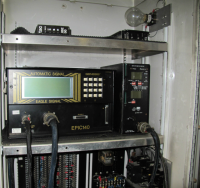
EF-140 controller unit. Photo from Signalfan
Macomb County initially wanted a solid state controller that mimicked the mechanical controllers due to the unusual timing/cycling patterns of Michigan intersections. [Please elaborate on what makes a Michigan intersection unique.] NEMA phase-oriented machines at the time did not provide as many options and flexibility as they do nowadays.
According to Scott Holzhei of MDOT (user "Kentron" on STF): Eagle Signal was the only manufacturer willing to develop an interval based machine.

Macomb County standard: EPIC140 in Eagle Size 4 cabinet
First model developed: EF140, interval based machine that was non-NEMA oriented. Individual timed intervals were mapped to specific outputs. Housed in an Eagle Size 4 (G) NEMA cabinet and worked with EDI conflict monitors and TSC load switches. The controller front panel connectors were not NEMA spec’ed
The menu driven model, EPIC140, used the same connectors and cabinet interface, but was menu driven and had more flexible programming. Options included four separate signal plans, time base clock, and pre-emption.
Both the EF and EPIC140 units were sold nationwide but only seen significant usage in Michigan.
EPIC140 controllers with EDI conflict monitors, housed in Eagle Size 4 pole-mounted cabinets became the standard controller used. It allowed for flexible timing and sequences including the flashing red left and single section right turn arrows, pre-timed time-of-day changes.
EPIC140s were also installed in Eagle Size M pole and base mount, M36 and P base mount cabinets and along most major corridors until recently.
Actuated signals were not common in Macomb County during the 90s and early 2000s except for low volume side streets and (rare) left turns. Where detection and more complicated programming was needed, EPIC140s were substituted with EPAC300 M30s.
EPICs fell by the wayside as intersections became more complex with TS2 detection, wireless broadband interconnection and as NEMA machines became more flexible.

Intelight 2070 in existing Eagle cabinet on Mound Road replaced in 2013 with an ITS 340 cabinet.
The first wave of modernization included EPAC300 M42s in base mount size P Eagle cabinets running TS2 Type 2. Eventually EPAC M50s made their mark. Iteris vantage video detection was standard. Some intersections began seeing Cohu survelliance cameras. First one I seen was at the intersection of Metro Parkway and Schoenherr. Flashing yellow arrows/boxspans, etc became standard for upgrades. Diagonal spans still common.
The second wave of modernization replaced corridors with 2070 equipment from Intelight. Mound Road was the first to be upgraded, but Schoenherr Road, and Hayes quickly followed. Video was primarily replaced with “Intersector” microwave sensors from MS Sedco most likely for better accuracy. More equipment such as video surveillance and GPS equipment became standard.
Some intersections had the 2070 equipment installed in the existing Eagle cabinet, others had their cabinets either removed, splice boxes installed, or used the old cabinet as a splice box. A large ITS cabinet with four access doors was installed for control. Microwave and radar detection became more common.
The third wave of modernization included most new intersections to be spec’ed with ITS cabinets standard, either Intelight or Siemens, possibly Econolite and McCain as well but haven’t seen evidence of their usage.
The four 340 ITS cabinets on the bid list for Macomb County were Intelight, Siemens, Econolite and McCain.
ITS cabinets allowed for more flexible software capabilities, more inputs and outputs for other equipment at the intersection, and faster processing speeds for PC, remote control. Road Commission of Macomb County spec
The first ITS cabinets installed were Intelight brands
As of October 2008, MDOT timing specifications allow for EF/EPIC and EPAC controllers for State-Maintained roads. MDOT Spec


